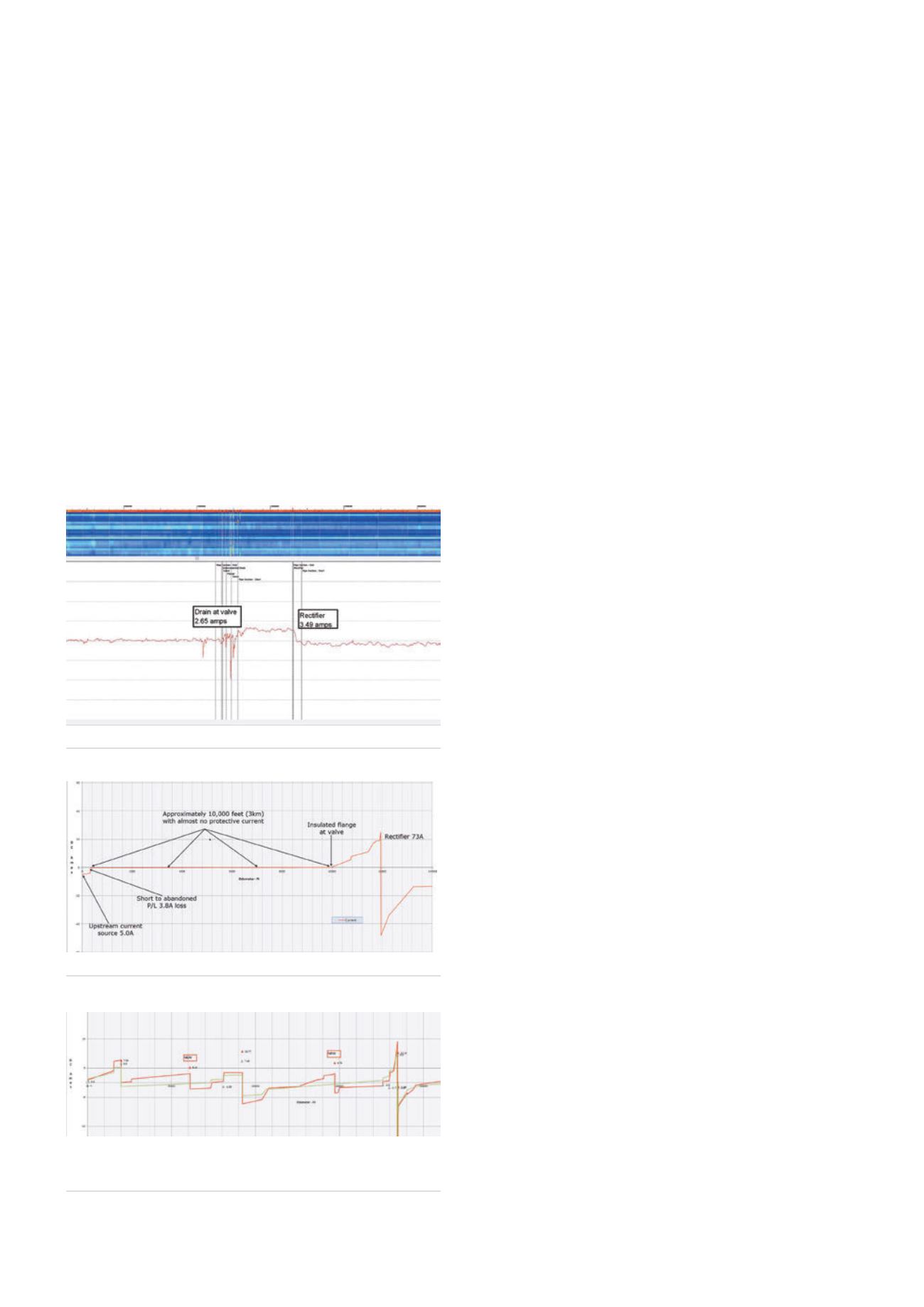
the business, some operators may use antiquated methods
to monitor CP system effectiveness. While these out-dated
methods may satisfy most regulatory requirements, they
may not provide the utmost confidence that the pipeline
is fully protected in all cases. Therefore, Shell and Baker
Hughes developed a tool that provides another dataset to
help understand the effectiveness of a pipeline CP system.
The CPCM
TM
tool measures the actual voltage drop in the
pipe wall that is caused by the CP current and converts this
value to a current using a simple Ohm’s Law calculation. This
axial CP current value is plotted against pipeline footage for
an unprecedented view of the current distribution along a
pipeline.
While there are no specific regulations that prescribe a
minimum required CP current density to achieve adequate
protection, axial current data provides unique insight into
exactly where and how much current collects on the pipeline.
By analysing the data, significant information about the
pipeline, including the pipeline coating and the CP system
effectiveness, is provided. CPCM provides a very critical piece
of the CP puzzle that could not be evaluated in previous
years.
Since operators are typically under serious budget
constraints, they may be unwilling to use new technology
unless it meets a specific regulatory requirement. However,
there are tools available that go beyond those required by
regulations and help operators to avoid pipeline failures. The
safety of people, property and the environment must always
take precedence, leaving no room for shortcuts in the pipeline
integrity management world.
When assessing pipelines, “what you don’t know” can be
much more important than “what you do know,” especially
in the case of pipeline corrosion and CP. One standalone
dataset rarely tells the entire story on its own. One way to
decrease uncertainty is to integrate as much data as possible
in an effort to identify all possible integrity threats, even those
hidden in areas where conventional test methods were not an
effective method of detection.
At present, CPCM inspections may not directly replace a
close interval potential survey (CIPS) since there is currently
no recognised criterion for CP current (although one is now
under development); however, the two definitely complement
one another. In an interrupted CIPS, the data is only accurate
if every current source/drain is identified and cycled. Failing
to interrupt one source or drain can invalidate an entire
survey, and this problem is exacerbated by the fact that
the existence of hidden sources and drains may never be
found using conventional survey techniques. CPCM excels at
identifying every CP current source and drain on a pipeline.
A recent CPCM inspection found that almost every valve site
on a particular pipeline was the site of substantial loss of CP
current due to grounded motor operator electrical conduit
(Figure 1).
Axial CP current data can reveal much about the
performance of pipeline CP systems, including findings that
call for immediate attention, or it may confirm that the
pipeline is being well protected. In Figure 2, a CPCM inspection
revealed a short to a foreign pipeline and an undocumented,
underground insulated flange that left approximately 10 000 ft
(3 km) of pipeline with little or no protective CP current across
a major waterway.
One operator used CPCM data from a 2011 inspection to
identify areas of low CP current density and then planned
eight additional CP rectifiers and anode beds. A subsequent
CPCM inspection made in 2013 after the installation of the
additional CP rectifiers confirmed they were installed in the
optimum locations. An overlay of both of these inspections
can be seen in Figure 3. It is plain to see that the new CP
rectifier installations significantly increased CP current density
in areas that had previously been low.
CPCM has been used to locate and size previously
unknown bonds to parallel pipelines. In this case, one pipeline
was all that remained active in a multiple pipeline corridor. All
of the pipelines had been protected by a common CP system.
It was suspected that many undocumented, underground CP
Figure 1.
Unwanted CP current drain at a valve site.
Figure 2.
Unprotected pipe discovered in a critical area.
Figure 3.
Comparison of CP changes using two CPCM
inspections confirmed that CP rectifiers were installed in
optimum locations.
44
World Pipelines
/
SEPTEMBER 2014


